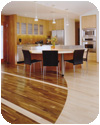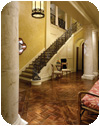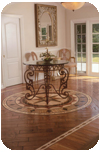
In recent years, there has been ample discussion in the flooring industry about the heightened demand for manufacturer finished wood flooring products. There is no doubt that these products remain popular with consumers, particularly those who are remodeling their home and want to minimize mess and disruption. Still, it may come as a surprise that unfinished wood flooring products remain a perennial favorite within the industry.
While industry insiders may have differing opinions about why this segment continues to dominate the industry, the enduring popularity of unfinished wood flooring products can most likely be summed up in one word: "customization."

Along with custom floor plans and state-of-the-art appliances, high-end hard surface flooring is an absolute must for many buyers. They demand something beyond the traditional 2-1/4 inch strip oak floors. Manufacturer-finished products may be available in a wide variety of options, but that is not enough for homeowners who want something that sets their home apart from the neighbor down the street. And they don't mind paying for it.
The opportunity has not been lost on those who market unfinished wood product. Over the past few years, exotic species have exploded onto the scene, tempting consumers with intricate grain patterns, colors and styles never before available. With exotic species now available from all corners of the earth, homeowners essentially can achieve any color they want without resorting to stains or dyes. Consider this small sample of eye catching options in the market for unfinished wood flooring:
- Bubinga, which originates in Africa, can appear pink, red, or reddish brown with purple streaks or veins.
- Australian Cypress offers a range from cream-colored sapwood to honey-gold heartwood, with dark brown knots holes throughout. ty pine, but is much harder and therefore more durable.
- Santos Mahogany, a South American species, offers a dramatic hue of dark reddish brown.
- Purpleheart,
- Burmese Teak, which originates in Asia, varies from a yellowish brown to a dark golden brown.
- Wenge, also from Africa, offers a totally unique look as it ages to a very deep brown, almost black, color.
Often, home owners cleverly incorporate these exotic offerings into their homes as accents, rather than a total flooring element. In addition to medallions and inlays, they use them to create borders-a simple upgrade that essentially creates a frame effect in a given area. Typically the border is created with a wood that contrasts sharply with the remainder of the floor. For example, a family room furnished with strip red oak, which is a medium colored wood, might include a border outlining the room in a contrasting species such as Brazilian Cherry, a much darker species of wood. The possibilities are endless, and are not limited to wood. Many borders now include intricate patterns that blend multiple wood species, stone, granite, marble, brass, copper, stainless steel, nickel and other metals. While these borders are available in manufacturer finished products, job-site finished products enable the consumer to personalize the home through customization.

Another popular customized wood flooring option is textured floors. Generally speaking, it is a process that distresses the wood to add character, warmth-and individuality. With the right treatment, a new floor can be made to appear weathered or antiqued. While textured manufacturer finished products certainly exist, hand-scraping is the most-common distressing technique. Using an arsenal of tools-including chisels, planes, grinders, wire brushes, chains, hammers, chisels, awls and saw blades-the installer will work with the wood to achieve a desired look. They can even create worm holes using drills and ice picks or give the floor a slightly singed look with a little carefully controlled burning. Of course, this type of distressing is a highly labor intensive process, but the end result will be a new floor that looks beautifully antiqued-and unlike any floor anywhere else.
While many of these approaches are nearly as old as wood flooring itself, installers are being helped by a number of advanced techniques and tools. The advent of dust containment sanding systems, for example, is eliminating one of the biggest issues homeowners confront. For many years, people shied away from site installations because of the swirling dust and disarray. Today, up to 95 percent of the dust normally associated with a job-site finished installation is vacuumed away. Without this mess to contend with, many consumers are now willing to go with customized jobs they might have avoided just a few years ago. They usually see the cost of a nearly dust-free installation as well worth it.

Surface finishes are very popular because they are durable, water-resistant and require minimal maintenance. Wax finishes soak into the pores of the wood and harden to form a protective penetrating seal. Acrylic impregnated finishes are injected into the wood to create a super-hard, extremely durable floor, which makes them ideal for commercial settings with high traffic areas, such as malls and restaurants.
Clearly, the unfinished segment of the wood flooring industry will continue to flourish in response to consumer demand for unique, one-of-a-kind wood floors that reflect their own personality, décor and lifestyle. It is a trend that has existed for more than two decades, and continues to thrive today.
Report Abusive Comment